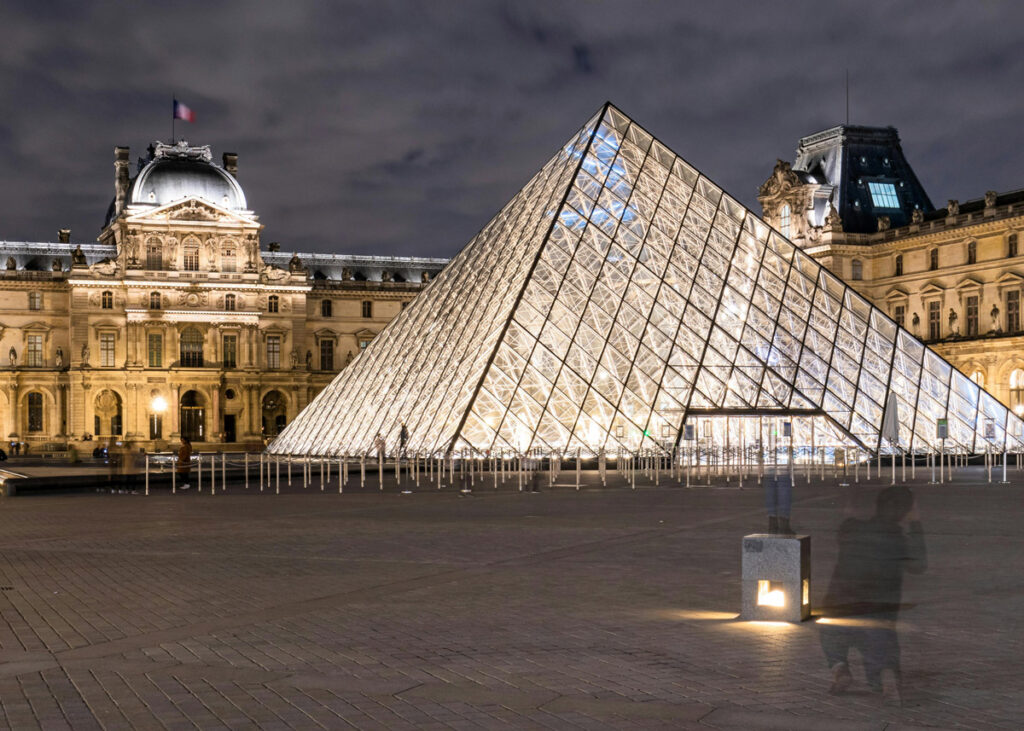
Eight stolen pieces of jewelry, seven minutes from start to finish, four thieves posing as construction workers, two display cases smashed, and one “mobile freight elevator” used to gain entry. These are the figures of the stunning jewelry heist that struck the famed Louvre in Paris — the most visited art museum in the world — around 9:30am on Sunday. Out of 35,000 objects and artifacts on display to choose from, the burglars focused singularly on pieces from the “Napoleon Jewels” and “French Crown Jewels” collections. The French Ministry of Culture has confirmed that two brooches, two crowns, two pairs of earrings, and two necklaces were stolen. While the monetary value of the jewels is undoubtedly high, it’s the historical and cultural significance that commentators are calling priceless and “inestimable.” Here’s what we know so far:
The heist: The team of thieves drove up to the side of the museum in what police described as a “mobile freight elevator” equipped with a metal ladder on the back that was extended up to a window, according to the Paris police. “They deployed the freight elevator, securing the surroundings with construction cones, before accessing the second floor, in the Apollo gallery, by breaking the window with an angle grinder,” according to the police statement. “Inside, they then smashed two display cases, ‘Napoleon jewels’ and ‘French crown jewels,’ using the angle grinder and stole numerous pieces of high-value jewelry.”
It all happened in mere minutes: Two of the thieves arrived at the museum in the mobile freight elevator, one wearing a yellow vest and the other an orange vest, according to police. Two accomplices arrived at the museum at the same time on what police described as “T-max vehicles” or sports motorbikes. “The staff on site, upon seeing what was happening, took to safety,” according to the police statement. “An alarm was triggered at 9:37 a.m. The perpetrators exited through the window by going back down the freight elevator before fleeing on the two motorbikes at 9:38 a.m.”
Diamonds & sapphires & emeralds (oh my): French Interior Minister Laurent Nunez, in an interview on local radio, said the value of the items would be “inestimable.” According to the French Ministry of Culture, among the items stolen was a diadem, or crown, from the collection of Queen Marie-Amelie and Queen Hortense; an emerald necklace and a pair of emerald earrings from the collection of Marie-Louise, Napoleon’s second wife; and a large bow brooch from Empress Eugénie’s bodice. The thieves either dropped or abandoned two pieces of jewelry as they exited the museum, including one of Empress Eugénie’s crowns, according to the Paris Prosecutor’s Office, which said it is investigating the case as an aggravated theft by an organized gang and criminal conspiracy to commit a crime.
An expert weighs in: Nathalie Abbou Vidal has spent her life surrounded by jewels that have lived through revolutions, crowned emperors and survived wars. As one of France’s leading jewelry historians, she teaches at the prestigious Haute Ecole de Joaillerie and advises major auction houses and the French courts. She told ABC News the idea that these treasures — “too important, too full of history, too much a part of who we are” — could be dismantled for profit is almost unthinkable. “The weight of the gold is nothing. The diamonds — they’re old European stones, centuries old. You can’t just break them apart,” she said. Even the black market, she believes, will struggle to erase the identity of the pieces. “They’re not just objects. They’re part of our heritage.”
Mon dieu! Well that’s sure to wipe the smile right off Mona Lisa’s face. The thing is, as the jewelry historian notes (sidenote: WHY didn’t I consider that seriously as a career?!), what are the thieves gonna do with the hot loot now? These are highly recognizable pieces, so while they’re probably worth more money as the treasured gems of heritage they are, trying to sell them as is would be an immediate tip off. The more plausible, yet devastating scenario, is that in order to make money off these jewels, they have to be deconstructed into parts. Even the larger stones, I think, would have to be broken down — sacrilege, I know! — in order to hide their provenance. Which is why art recovery experts have been saying that if the jewels aren’t recovered between 24-48 hours after the theft, then it’s all over. The criminals may be caught, but it’s most likely a lost cause for the gems after that point. So the clock started at 9:30am Sunday, local Paris time. That puts 48 hours later at… Merde.
PS — As of this writing, the Daily Mail has restrained themselves from writing the headline “Priceless jewels stolen from the Louvre two weeks after Duchess Meghan visits Paris!” Let’s see how long they last.
photos credit: Anna Shvets, Kirandeep Singh Walia and Thomas Ortega on Pexels, Getty














This could have been an episode of Lupin.
Yep. Or a case for Hercule Poirot.
Both! <3
We’ve been to the Louvre a few weeks ago. While we were planning our route — the whole palace/museum is gigantic, more than seventy thousand m² — we decided we’d do the crown jewels some other day.
Oh, well.
Fingers crossed, trois fois merde (the superstitious version of good luck), for the Louvre that the jewels will be found eventually, even if we’re already outside the time frame for the recovery…
I wonder if this is an example of a crazed collector wanting them for his private collection. They may never be seen again as they disappear into a vault. We need Inspector Closeau!
Exactly what I was thinking. The job was probably done for a specific private collector.
The Pink Panther did it!
Absolutely. This was a to order job. Some multi-billionaire oligarch wanted them, knowing that they are not and never will be for sale. So he hired people to steal them. This was meticulously planned and expensive to put together. Someone paid a lot of money to have those specific pieces taken. They will probably not be broken down, but they will not be seen in public again.
My take too. It was commissioned.
It will be very difficult for the theives to sell them. I hope they will be able to find them.
Given how hard it would be to sell these jewels, I’m wondering if it’s some billionaire oligarch (or similar) who is ultimately responsible for this heist, and that person just wants to keep the jewels in a private collection. Or maybe I read too many bad international thriller novels!
That’d probably be best case scenario if the jewels are to ever be recovered in tact.
I agree they already have a buyer and it’s some billionaire who is going to keep them in his bunker somewhere. They have to have everything!
I agree – they already had a buyer in mind. It’s like art thieves. There is a market for these things, but often it’s organised in advance, to then be kept in private collections.
Theory is that the thieves were commissioned to steal specific pieces. So hopefully that means they are intact in someone’s private collection.
This makes me so sad they were such beautiful pieces. My guess, they will be broken down to sell individually. I read they found one of the crowns near the museum.
I went to the Louvre in 2000 it’s absolutely gigantic. It would be impossible to protect every area of it. Even with hundreds of cameras. I tried to see everything in one day. Which was a mistake. It’s all a blur now and I didn’t really enjoy it. You really have to just pick an area and immerse yourself in it.
Years ago, when I visited the British Museum & thought that might be my only opportunity in life, I made a concerted effort to see everything. Pretty sure I did, but I felt miserable. Physically miserable. And then came down with a killer cold. Thereafter, I give myself a max of two hours in any museum, no matter what. I tell myself I will enjoy whatever I see in those two hours & I will be happy with that. I’ve stuck with that plan for the last 30 years.
OK, I confess, I don’t include the museum gift shop in those two hours. 😉
That heist was probably for a private collector who’s filthy, nasty rich and willing to pay a price that’ll retire the thief’s career forever.
That’s what I think too. Someone hired them.
Inside job.
Totally. The gall to do it with the museum open is what shocks me.
Seems like they had plan and if they grabbed specific items, maybe they already had a buyer for the jewelry as it is?
50 years from now, someone will be cleaning out eccentric Great-Uncle Albert’s crumbling mansion. Find some necklace with green stones, a gorgeous blue tiara, and everyone will be amazed by my prediction!
That literally happened in 2017 with a William de Kooning. It was stolen 30 years before and ended up in a house in New Mexico hanging behind a door. Crazy story. Look up Rita and Jerome Alter.
Exciting! Why do I always root for the thieves?! Something about the thrill? I watch too much of the dumb box. I hope the jewels are found and I am happy no one was hurt.
I didn’t know that I needed a news story about a good old-fashioned jewelry heist. This story and the internet’s response to it has been so entertaining. I should feel bad for the Louvre, I love the museum and visited it this spring, but this is just delightful to watch unfold. All the details make for a movie I would love to watch.
It’s giving Carmen San Diego! 💎
Nothing like a good old fashioned jewel heist to take one’s mind off of the horrors.
My mind immediately goes to The Great Muppet Caper. I’m sorry, I can’t help myself.
Coincidentally, the BBC just put an article out on Friday about art museum heists of the 1970s. In the last paragraph an art crime expert talks about how such brazen heists have become less common because of how hard it is to fence the art. I read this on Friday morning and then just two days later I woke up to the story of the Louvre heist.
Another museum heist recently happened in Egypt, where the gold and lapis bracelet of a pharaoh was stolen and melted down before they caught the thieves. I know we’re outside of the 48 hour window but I’m still hoping they’re caught before it’s all broken down.
I read a great book about the theft of The Scream from the National Gallery in Oslo in 1994 (it was one of four that Munch created). It was just hanging on the wall, next to a window; the thieves stuck a ladder against the wall, climbed up, went through the window, and took it. Over in a matter of minutes.
A quick google tells me The Scream (which version, I don’t know) has been stolen more than once!
At first I was laughing and then I read somewhere that part of the taxes that we pay in France is supposed to go to the maintenance and security of the Louvre.